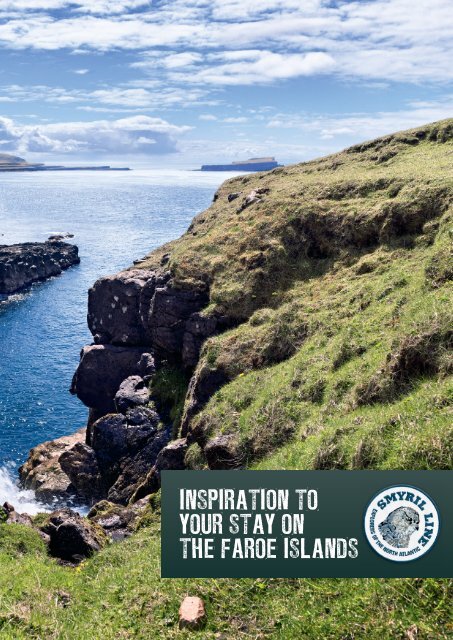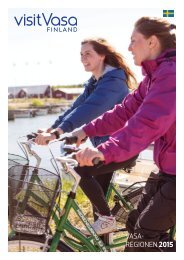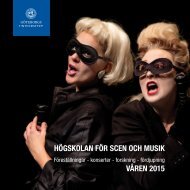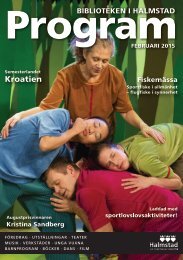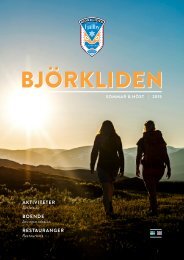INSPIRATION TO YOUR STAY ON THE FAROE ISLANDS
With only 20,000 inhabitants, Tórshavn is not just one of the world’s smallest capitals, but also one of the most charming ones. This dynamic city, with its creative, inno va tive and highly educated population, is the political and cultural hub of the Faroes, and, fond as they are of their traditions and cultural legacy, local residents are also keen to embrace emerging global trends. All this means that Tórshavn offers a fascinating mix of Faroese cultural history and all the amenities you would expect to find in a modern 21st century capital. The city is a melting pot of old and new. To take in its contrasts, explore Tórshavn starting from its oldest area down by the harbour, Tinganes, where little grass-thatched houses stretch along narrow meandering alleys then stroll up towards the mountainsides, you will find that the residential neighbourhoods grow younger and trendier as you ascend.
With only 20,000 inhabitants, Tórshavn is not just one
of the world’s smallest capitals, but also one of the most
charming ones. This dynamic city, with its creative, inno
va tive and highly educated population, is the political
and cultural hub of the Faroes, and, fond as they are of
their traditions and cultural legacy, local residents are also
keen to embrace emerging global trends. All this means
that Tórshavn offers a fascinating mix of Faroese cultural
history and all the amenities you would expect to find in a
modern 21st century capital. The city is a melting pot of old
and new. To take in its contrasts, explore Tórshavn starting
from its oldest area down by the harbour, Tinganes, where
little grass-thatched houses stretch along narrow meandering
alleys then stroll up towards the mountainsides, you
will find that the residential neighbourhoods grow younger
and trendier as you ascend.
Create successful ePaper yourself
Turn your PDF publications into a flip-book with our unique Google optimized e-Paper software.
<strong>INSPIRATI<strong>ON</strong></strong> <strong>TO</strong><br />
<strong>YOUR</strong> <strong>STAY</strong> <strong>ON</strong><br />
<strong>THE</strong> <strong>FAROE</strong> <strong>ISLANDS</strong><br />
1
><br />
><br />
VIEW FROM<br />
HOTEL HAFNIA >><br />
2<br />
TÓRSHAVN<br />
With only 20,000 inhabitants, Tórshavn is not just one<br />
of the world’s smallest capitals, but also one of the most<br />
charming ones. This dynamic city, with its creative, inno<br />
va tive and highly educated population, is the political<br />
and cultural hub of the Faroes, and, fond as they are of<br />
their traditions and cultural legacy, local residents are also<br />
keen to embrace emerging global trends. All this means<br />
that Tórshavn offers a fascinating mix of Faroese cultural<br />
history and all the amenities you would expect to find in a<br />
modern 21 st century capital. The city is a melting pot of old<br />
and new. To take in its contrasts, explore Tórshavn starting<br />
from its oldest area down by the harbour, Tinganes, where<br />
little grass-thatched houses stretch along narrow meandering<br />
alleys then stroll up towards the mountainsides, you<br />
will find that the residential neighbourhoods grow younger<br />
and trendier as you ascend.<br />
Set in beautiful surroundings embraced by mountains on<br />
the one side and looking out onto the ocean on the other,<br />
Tórshavn holds myriad exciting experiences and attractions<br />
in store. The bright multi-coloured houses have led visiting<br />
journalists to describe the city as one of dreamlike beauty,<br />
which could have been taken straight out of a fairy tale.<br />
Skansin, the Fort of Tórshavn, was built in 1550 to protect<br />
the city from pirates. Today it is hard to imagine how the<br />
little watch house and the delicate decorative canons could<br />
have saved the city and its residents from pillaging. Fortunately,<br />
there is no longer any need for guards patrolling<br />
Skansin, nowadays you are more likely to encounter couples<br />
on a romantic stroll and children running through the<br />
grass or straddling across the canons, which are unlikely<br />
to ever be heard again.<br />
Tinganes is the old historic area of Tórshavn and, along<br />
with Reyni, makes up Tórshavn of old. These neighbourhoods<br />
once made up the hub of commerce in the Faroes<br />
and, although the city has grown exponentially since then,<br />
they remain central to life on the islands, as the superbly<br />
preserved charming red and black grass-thatched buildings<br />
are today home to the Faroese Government. And this<br />
is more than just an administrative quarter, there is still life<br />
in the narrow cobbled streets where sights and sounds testify<br />
to the lives of the families, who still call this enchanting<br />
outpost of history home.<br />
Tórshavn’s landmarks include a number of statues, new<br />
as old, each with their special story or significance, most<br />
were created by local artists – a testament to the creativity<br />
and fondness of art the Faroese people. A walk from the<br />
harbour up towards the Nordic House will take you past<br />
a number of them: head up from the harbour through the<br />
town centre, past the old red theatre, then turn into the<br />
park along Havnará (Tórshavn river), cross through the<br />
local park to the National Gallery of the Faroe Island on<br />
its other side and then head for the Nordic House. On this<br />
walk, right behind the theatre you will first encounter the<br />
statue of Hans Andrias Djurhuus, who was born and bred<br />
in the city and in the early 20th century wrote songs and<br />
stories that became central to the Faroese identity. When<br />
you cross the road and turn onto the river path, you face a<br />
fierce dragon rising out<br />
of the stream,<br />
it was<br />
<strong>FAROE</strong> <strong>ISLANDS</strong><br />
S<br />
created by<br />
Tróndur<br />
Patursson,<br />
who is known<br />
Tórshavn<br />
for sculpting magic out<br />
of glass. A bit further along you<br />
will spot one of the multi-talented<br />
Faroese author William Heinesen’s<br />
iconic fantasy women. In the heart<br />
of the park, you will find the memorial<br />
to sailors lost at sea and when<br />
you reach the National Gallery, you<br />
will be welcomed by the bronze<br />
works sculpted by Hans Pauli<br />
Olsen that grace the Gallery’s<br />
surrounding. The National Gallery<br />
of the Faroe Island is home<br />
to the world’s largest collection of<br />
Faroese art, it is estimated to hold<br />
a total of 2600 pieces, most of them<br />
Faroese. A visit provides an excellent overview<br />
of Faroese art history with works by artists such as<br />
Mikines, Ruth Smith, Ingolvur av Reyni, William Heinesen,<br />
as well as younger artists, including Hanni Bjartalíð and<br />
Edvard Fuglö, to mention a few of the renowned artists<br />
whose work is on display here.<br />
Last, but not least, the Nordic House experience begins<br />
before you even reach it, as you approach you will find that<br />
it is reminiscent of an enchanted elven hill shrouded in<br />
mystery. Although it hosts a wide variety of events yearround,<br />
everything from concerts to plays, lectures and<br />
exhibitions, it is an oasis of tranquillity and most certainly<br />
a place worth visiting, be it for refreshments at the café, to<br />
catch an exhibition or just to experience the architecture<br />
and soak up some Nordic culture.<br />
The Nordic House cafe is not the only place we would recommend<br />
that you get a bite. Tórshavn offers a whole range<br />
of dining experiences, there are a number of cosy cafes<br />
serving light meals, particularly in the town centre, you<br />
could dig into a succulent fish and seafood buffet at Hotel<br />
Hafnia, or take lunch in style at the converted harbour<br />
warehouse Öström, where you can also acquire arts and<br />
crafts from local artisans, for contemporary fusion cooking<br />
try Faroese sushi at Etika, or, for an extraordinary culinary<br />
experience, head up to restaurant KOKS, which was<br />
nomi nated as Restaurant of the Year by the Danish Dining<br />
Guide (Den Danske Spiseguide) in 2013.<br />
Tórshavn is at the heart of the Faroes and it is very well<br />
connected. The capital is an excellent basis from which to<br />
explore even the remotest corners of the archipelago. Travelling<br />
is easy, so why not head out to the imposing islands<br />
where the most amazing experiences and surprises await<br />
you. All you have to do is seize the opportunity to explore<br />
this modern society steeped in tradition and set in majestic<br />
surroundings in the middle of the North Atlantic.<br />
3
<br />
>><br />
<strong>THE</strong> ARTIST<br />
TRÓNDUR<br />
PATURSS<strong>ON</strong><br />
4<br />
PRESERVA-<br />
TI<strong>ON</strong> OF<br />
ST. MAGNUS<br />
CA<strong>THE</strong>DRAL >>
KIRKJUBÖUR<br />
The village Kirkjuböur is the place in the Faroes where<br />
you will find the most remarkable relics of the past. During<br />
the Middle Ages the village was the cultural and religious<br />
centre of the Faroes and part of the Catholic Church of<br />
Norway. The seminary in Kirkjuböur was the first and only<br />
one in the Faroes up until the reformation in 1538. King<br />
Sverri of Norway grew up here, where he also attended the<br />
seminary and was ordained.<br />
Today there are around 80 inhabitants in Kirkjuböur,<br />
which is a 15-minute drive from Tórshavn. Kirkjuböur<br />
boasts three buildings, in particular, which no visitors<br />
to the Faroes should miss: the Kirkjuböargarður estate<br />
farmhouse that is currently home to the 17th generation in<br />
the Patursson family. The oldest part of the house is the<br />
formal reception room, Roykstovan, it dates back to the<br />
11th century and currently functions both as a museum<br />
and to welcome<br />
guests on special<br />
occasions. St. Olaf’s Church,<br />
the local parish church (from<br />
around 1200) is the only medieval<br />
church, which is still in use in the<br />
Faroes. Last but not least, there are<br />
the imposing ruins of the Magnus<br />
Cathedral, which was built around<br />
the year 1300.<br />
<strong>FAROE</strong><br />
ISLNDS<br />
S<br />
Kirkjuböur<br />
5
LEYNAR >><br />
><br />
>><br />
VESTMANNA<br />
><br />
6<br />
WAX<br />
MUSEUM >>
KVÍVÍK, VESTMANNA AND <strong>THE</strong><br />
VESTMANNA BIRD CLIFFS<br />
On your way to Vestmanna you will pass both Leynar and<br />
Kvívík, two beautiful villages with each their landmarks.<br />
The village Leynar tapers off down a rolling mountainside<br />
surrounding one of the most picture-perfect sand beaches<br />
in the Faroes with a breath taking view of the islands Koltur<br />
and Vágoy. This is a very popular spot among young<br />
people and families with children.<br />
Having passed Leynar, turn off the main road and down a<br />
rather steep and narrow approach to reach Kvívík. Kvívík<br />
boasts a Viking excavation site, indicating that it is one of<br />
the oldest settlements in the Faroes. The site is near village<br />
church, which was inaugurated in 1903 and its charm<br />
makes it well worth a visit. The village is very pretty, so<br />
take your time for a stroll along the river and explore it.<br />
If you follow the road further North from Kvívík, you will<br />
reach Vestmanna, one of the larger villages in the Faroes,<br />
located on the northwest coast of Streymoy. Vestmanna is<br />
the starting point for excursions to the awe-inspiring bird<br />
cliffs and grottos known as Vestmannabjörgini. In high<br />
season there are several daily departures for the bird cliffs,<br />
this is a popular excursion, both among international and<br />
local visitors. The boats sail along the mountainside and<br />
up to the cliffs themselves, which face the Atlantic sea<br />
head on, before heading through narrow straits and into<br />
deep grottos formed by the crashing waves over millions<br />
of years, to bring you close to the 600-metre-high vertical<br />
wall of rock where thousands of seabirds breed. In these<br />
Vestmannabjörgini<br />
Vestmanna<br />
majestic<br />
Kvívík<br />
surroundings<br />
you<br />
<strong>FAROE</strong><br />
SL<br />
can but feel at<br />
one with nature, part of<br />
it, and you will understand why<br />
a deeply rooted respect for the<br />
forces of nature permeates Faroese<br />
culture. Nature has its way of making<br />
an impression and visitors to<br />
Vest manna björgini often return to the<br />
quayside in Vestmanna feeling both<br />
uplifted and cleansed. You should<br />
probably get a few pictures to<br />
remember the bird cliffs by and<br />
perhaps impress friends and<br />
family back home.<br />
AROE <strong>ISLANDS</strong><br />
S<br />
After the sailing trip, we recommend<br />
a visit to the SagaMuseum, which you<br />
will find above Restaurant Fjörukrógvin.<br />
This is the Vestmanna wax museum and getting to experience<br />
such a vivid rendition of Faroese history is quite a<br />
rare treat. Lights, sounds and even scents come together to<br />
bring history to life. As you stroll through the landscapes<br />
and among the wax figur ines, the history of the Faroe<br />
Islands is whispered into your ears through the headset,<br />
bringing you closer to history itself.<br />
7
><br />
>><br />
GÁSADALUR<br />
>
VÁGAR<br />
Vágar island is home to the biggest lakes in the Faroes<br />
and Sörvágsvatn takes pride of place as the island’s main<br />
road follows its shores. A walk along the lake out to the<br />
Bössdalafossur waterfall is as lovely as it is leisurely<br />
and richly rewarded – the view from this spot can be<br />
either dramatic or tranquil, depending on the strength<br />
of the currents and the power of the surf. The headland<br />
Trælanípan, whose name – literally slave headland –<br />
marks a sinister chapter in Faroese history, lies south of<br />
the waterfall and is easily accessible on the walk around<br />
the lake. Local lore has it that when slaves caught for<br />
steeling sheep or similar offences were sentenced to<br />
death, they were executed by a push over the promontory’s<br />
edge and into the sea from Trælanípan’s summit.<br />
The walk up Trælanípan is not strenuous and once you<br />
reach the summit, try to lie down right out by the edge<br />
and look straight across the ocean from the 146-metre<br />
high promontory, time will come to a halt and the incredible<br />
view of the islands will become a life-long memory.<br />
The tiny village Gásadalur is now connected by a road<br />
through a tunnel to the rest of the islands, but up until<br />
fairly recently the inhabitants had to trek over the mountain<br />
to the village<br />
Böur before<br />
they<br />
F<br />
could<br />
Gásadalur<br />
continue<br />
their journey<br />
by car, bus or<br />
boat like everyone else.<br />
Steep mountains in a stunning<br />
landscape cradle the little hamlet<br />
with its beautiful view over<br />
Tindhólmur. Here life is lived at a<br />
completely different pace and tranquillity<br />
descends as you emerge<br />
from the tunnel and enter this<br />
idyllic setting. You can still<br />
choose to hike to Gásadalur<br />
over the mountain along the old<br />
postal route, the view of the village<br />
and ocean beyond when you<br />
reach the summit you is remarkable.<br />
<strong>FAROE</strong> <strong>ISLANDS</strong><br />
S<br />
9
GANNET >><br />
><br />
>><br />
<strong>THE</strong> VILLAGE<br />
MYKINES<br />
><br />
>
MYKINES<br />
Mykines island is the westernmost outpost of the Faroes.<br />
This island is known for its teeming birdlife as it attracts<br />
hundreds of thousands of migratory birds, which nest<br />
here in summer. Mykines is also home to the only gannet<br />
colony in the Faroes, which in itself makes it quite the attraction,<br />
but the charming little puffins with their colourful<br />
beaks are probably the island’s main lure, possibly because<br />
they are usually happy to pose with their beaks full<br />
of fish.<br />
Sailing to Mykines takes just under one hour and is one<br />
of the best ways to see Tindhólmur up close. Tindhólmur<br />
is a steep cliff islet just off Vágoy. Once the boat reaches<br />
Mykines itself, it sails along the bird cliffs on the south<br />
side of the island, before dropping anchor in the village.<br />
Mykines<br />
You should absolutely take the<br />
trip out to the islet Mykineshólmur<br />
with its lighthouse, which<br />
will bring you across the hanging<br />
bridge connecting it to Mykines.<br />
It is an easy hike, but, although the<br />
hanging bridge is completely safe,<br />
it can be a bit of a challenge for<br />
those who fear heights as it<br />
stretches across a 35-metre<br />
deep gully with the heaving<br />
Atlantic at the bottom.<br />
<strong>FAROE</strong> <strong>ISLANDS</strong><br />
S<br />
11
GJÓGV<br />
and other attractions in the area<br />
Tjörnuvík<br />
Saksun<br />
Eiði<br />
Gjógv<br />
The most photographed village in the Faroes is probably<br />
Gjógv, which is located in the northernmost part of<br />
Eysturoy. In order to reach Gjógv you will have to cross<br />
a high mountain ridge from where you will see a large<br />
green valley with striking mountains on both sides. At<br />
the very bottom of the valley, the colourful houses are<br />
dotted around a beautiful crystal-clear river with a little<br />
dam where children play all summer. But the village is<br />
best known for its natural harbour. Gjógv means gorge in<br />
Faroese and it is precisely in the great gorge cutting into<br />
the landscape that the natural harbour is located. Take<br />
all the steps down into the gorge, down to the harbour<br />
and take in the immense power of nature in surroundsound.<br />
The coastal area where the village is located is low,<br />
however, eastwards, towards Múli, and onwards around<br />
this headland to the southeastern coast, the coast rises<br />
steeply from the sea. In the other direction, a deep valley<br />
stretches down towards the village and almost parallel to<br />
it, across the ridge, you will find another of nature’s gems,<br />
Ambadalur valley. The hike to Ambadalur is one of the<br />
most popular in the Faroes and is rewarded with the view<br />
of the tallest freestanding cliff column in the Faroes called<br />
Búgvin.<br />
There are two roads to Gjógv and, to make the most of the<br />
trip, you could take one on the way to the village and the<br />
other when you depart. If you are out exploring in your<br />
own vehicle, you should make the most of it and do the<br />
whole itinerary with Funningur, Gjógv, Slættaratindur,<br />
Risin and Kellingen, Tjörnuvík and Saksun. This would<br />
be a full day-trip leaving you with lasting impressions of<br />
magnificent landscapes and lots of fresh air.<br />
Funningur is located in the fiord Funningsfjörður, it is<br />
a charming little village that has a beautiful traditional<br />
church built in 1847 with tarred walls, grass clad roof and<br />
a bell tower. The village is at the bottom of a valley and the<br />
homes here follow along the river streaming down from the<br />
steep surrounding mountains. From Funningur you travel<br />
up along the mountain road to Gjógv.<br />
Having visited Funningur and Gjógv the mountains beckon,<br />
because this is where you will find the highest mountains<br />
in the archipelago. Slættaratindur with its 882 metres<br />
is the tallest and next to it towers Gráfelli with its 857<br />
metres as the second tallest mountain in the Faroes. If you<br />
take the mountain road from Gjógv to Eiði, you will drive<br />
through the pass between Slættaratindur and Gráfelli. You<br />
will already be around 400 metres above sea level here, so<br />
the hike all the way up to Slættaratindur’s summit is not<br />
as strenuous as it might otherwise seem. This is probably<br />
also why so many can boast that they have been to the<br />
summit of the Faroes where the view is dazzling. When<br />
the skies are clear, the view from Slættaratindur’s summit<br />
spans all 18 islands making up the Faroes – or almost at<br />
least.<br />
Off Eysturoy’s northern coast you will spot the sea stacks<br />
Risin and Kellingin. Legend has it that the giant, Risin,<br />
<strong>FAROE</strong> <strong>ISLANDS</strong><br />
S<br />
and the<br />
hag, Kellingin,<br />
were on<br />
a mission from Iceland<br />
to steal the Faroes<br />
and haul them up to Iceland.<br />
Giants and hags are, of course,<br />
creatures of the night and they<br />
knew that they had to hurry before<br />
the sun came up. Unfortunately for<br />
them, they were so consumed by<br />
their task this one night that they<br />
did not reach shelter before the<br />
sun’s first rays hit team and<br />
turned them to stone. Since<br />
then, the pair has stood there<br />
gazing longingly towards their<br />
home country. Eiðiskoltur, the<br />
mountain where they fastened their<br />
rope, still bears the mark of their work,<br />
as the cliff cracked when they tugged on the<br />
rope in their futile efforts.<br />
Risin and Kellingin can be admired from both Slættaratindur<br />
and Tjörnuvík, but the best vantage point is from the<br />
road between Slættaratindur and Eiði. A telescope is available<br />
there for you to take a closer look at these mysterious<br />
creatures.<br />
Tjörnuvík in northern Streymoy is a pretty little village in<br />
a cove girded by tall mountains; in fact, the mountains are<br />
so tall that they block out all direct sunlight for a couple of<br />
months every winter. Tjörnuvík has a large sandy beach<br />
with a view over the sea stacks Risin and Kellingen off the<br />
northernmost point of Eysturoy. Tjörnuvík is also known<br />
for its musical heritage, here, villagers have remained<br />
faithful to the old singing traditions and still sing hymns in<br />
the old Kingo style.<br />
Saksun is one of the archipelago’s great surprises. In<br />
order to reach Saksun, you have to drive through a long<br />
valley from the village Hvalvík. After driving past the<br />
picturesque lake, Saksunarvatn, the village suddenly<br />
emerges from the landscape. A deep ravine runs through<br />
the village and you will have to stay on its right to reach<br />
the smallest neighbourhood where there is a wonderful<br />
little museum, Dúvugarður, which will allow you to catch<br />
a rare glimpse of what life was like on a farm in the old<br />
days. This is also where you will find the beautiful chalked<br />
church with a grass roof clinging to the mountain rim. If,<br />
on the other hand, you choose to turn left, the road will<br />
take you through the village and from here you should<br />
continue on foot into the immense stunning bay. There is<br />
a sandy beach in the bay itself, and, when the tide is low,<br />
you can walk out through the bay, along the beach, and<br />
out towards the even larger sandy beach, which faces the<br />
Atlantic unguarded. Do remember the tidal times, though,<br />
as you will not be able to walk along the beach out through<br />
the bay, or back again, when the tide is high.<br />
13
><br />
KUNOY IS<br />
<strong>THE</strong> HIGHEST<br />
ISLAND OF<br />
<strong>THE</strong> <strong>FAROE</strong>S >><br />
><br />
>
KLAKSVÍK<br />
Klaksvík is the second-largest city in the Faroes and<br />
home to around a tenth of the country’s population.<br />
Pyramid-like mountains encircle it with a wonderful<br />
bay on both sides. Klaksvík is also one of the Faroes’<br />
most important ports and trade is busy here. The local<br />
residents are very engaged and they have a knack for<br />
creating and hosting events that draw visitors from the<br />
entire country – most take place in summer and many are<br />
recurring annual events.<br />
To reach Klaksvík you have do drive through the subsea<br />
tunnel connecting to it from Leirvík. Tunnels always have<br />
an aura of mystery, particularly when they run under the<br />
sea, but the artist Tróndur Patursson was given opportunity<br />
to leave his mark on this particular tunnel, which<br />
makes it a pleasure to drive under the seabed where the<br />
artist has used light and colours to breathe life into the<br />
tunnel’s basalt walls.<br />
In Klaksvík we particularly recommend visiting the<br />
beautiful park area Úti í Gröv, which is on the outskirts<br />
of the city. This picturesque oasis has been a source of<br />
inspiration for many creative souls and it is a lovely place<br />
to enjoy a moment of stillness in beautiful surroundings<br />
– and perhaps a packed lunch. Should you have forgotten<br />
to pack lunch, no need to worry, you will pass Jórun’s<br />
bakery – Bakaríð Jórun – on your way into Klaksvík, the<br />
establishment is known for its scrumptious bread, excellent<br />
sandwiches and divine cakes.<br />
Christianskirkjan was the first church in Scandinavia to<br />
be built in the Old Norse style; it is a stirring monument<br />
to Klaksvík and not to be missed. The church was built<br />
in 1963 and was considered highly unusual, as it did not<br />
feature a bell tower. A bell tower was since added, but it<br />
is detached, it was placed next to the church building.<br />
Allow not history to die, reads a line from a famous<br />
Faroese song and at The Northern Museum, which was<br />
founded in the late 1960s, history is certainly kept alive.<br />
The museum showcases household utensils, tools, fishing<br />
gear and other effects from daily life in the old days.<br />
The building where<br />
the museum is located<br />
was built for the local<br />
Royal Danish<br />
Monop-<br />
FA<br />
RO<br />
oly store<br />
in 1838.<br />
Adjacent to it<br />
is another exhibition<br />
in Apotekið, the Apothecary<br />
Shop, which also looks the way<br />
it did in the old days.<br />
AROE<br />
ISLA<br />
SLAND<br />
LANDS<br />
Klaksvík<br />
Klaksvík is the central hub of<br />
the Northern Isles: Kalsoy, Kunoy,<br />
Borðoy, Viðoy, Svínoy and Fugloy.<br />
The Northern Isles are characterised<br />
by towering mountains<br />
on the eastern side the islands<br />
taper down towards a jagged<br />
coastline, which cuts the slopes<br />
off into low cliffs, while the northern<br />
side is characterised by rugged<br />
majestic cliff promontories. The two<br />
smallest islands, Svínoy and Fugloy,<br />
can only be reached by boat or helicopter, while bridges,<br />
dams and tunnels interlink Kunoy, Borðoy and Viðoy, but<br />
you will need to catch the ferry to get to Kalsoy. If you<br />
have made it all the way to Klaksvík, you really owe it to<br />
yourself to explore the region. Viðareiði is an excellent<br />
place to start; it offers unparalleled panoramas of Borðoy,<br />
Kunoy, Kalsoy and Fugloy, because the village boasts<br />
open ocean views both eastward and westward. Straight<br />
north of the village stands the world’s tallest promontory,<br />
Enniberg, with its imposing 750 meters. Viðareiði also<br />
boasts one of the most beautiful and well-known rectories<br />
in the Faroes.<br />
Kunoy is, on average, the highest island in the Faroes.<br />
The village, also called Kunoy, is beautifully scattered<br />
across the island’s western side and is graced with a<br />
view of neighbouring, Kalsoy, which, when the evening<br />
sun casts its shadows across the island almost looks like<br />
a gigantic Toblerone bar.<br />
15
SKOPUNS<br />
HARBOUR >><br />
><br />
<strong>THE</strong> VILLAGE<br />
SANDUR >><br />
<br />
>
SANDOY<br />
Sandoy is the fifth largest island in the Faroes and, along<br />
with Suðuroy, makes up the large southern island pair in<br />
the archipelago. Sandoy is considered the flattest island,<br />
with broad valleys and many little lakes, low rounded<br />
mountains and sandy beaches. The gently rolling mountains<br />
make it appear greener than the other islands with<br />
their more rugged craggy mountains. The island’s western<br />
coast is steeper and has bird cliffs.<br />
There are historical gems to be discovered in Sandoy. Visit<br />
Húsavík, a little village dating back to the Viking ages, it<br />
has two old quarters with many traditional Faroese houses.<br />
In the middle of the village you will find the 13 th century<br />
vestiges of a great homestead, which once belonged to the<br />
rich and powerful lady of Húsavík, Guðrun Sjúrðardóttir,<br />
who, legend has it, was a rather<br />
ruthless mistress and businesswoman.<br />
Near the ruins stands the<br />
protected home of Jóannes á Breyt, Sandur<br />
which is 130 years old and now<br />
used as the local museum.<br />
The village Sandur has a lovely<br />
art museum with a fine collection<br />
of modern Faroese art. A<br />
visit to the Sandur Art Museum<br />
is an absolute must on a trip to<br />
Sandoy.<br />
<strong>FAROE</strong> <strong>ISLANDS</strong><br />
S<br />
Húsavík<br />
17
><br />
><br />
<br />
18<br />
VÁGUR >>
SUÐUROY<br />
The crossing to Suðuroy, which is the southernmost island<br />
in the Faroes, takes around two hours from Tórshavn on<br />
board the modern ferry Smyril. Do get out on deck during<br />
the trip; sailing is the ideal way to take in the islands and<br />
the ever-changing seascape. Go outside enjoy the rush of<br />
fresh air and the spectacular views of the islands Nólsoy,<br />
Streymoy, Hestur, Koltur, Sandoy, Stóra Dímun and Lítla<br />
Dímun, which you get up close to on your travel south.<br />
Suðuroy is unique in itself, not just culturally, but also geologically.<br />
In contrast with the other islands in the archipelago,<br />
which are mostly carved out of the top-most basalt<br />
series, Suðuroy is made up of the lower and middle basalt<br />
series with coal and columnar basalt. When the ferry sails<br />
into the port of Tvöroyri, you will notice the impressive<br />
sculptural columnar basalt, which looks almost like a piece<br />
of Faroese art.<br />
Suðuroy is characterised by fiords and beautiful beaches<br />
on its eastern board and majestic summits on its western<br />
board, there are not many places in the Faroes where you<br />
can get as close to the mountains as you can in Suðuroy.<br />
The roads will take you almost to the very edge of magnificent<br />
bird cliffs and your gaze will be drawn towards dizzying<br />
precipices as you drive past.<br />
Let us begin all the way south, where you can drive along<br />
the old village road between Lopra and Sumba and up to<br />
the area called Hesturin. Here you will experience Beinisvörð,<br />
the second-tallest promontory in the Faroes up close,<br />
but do take note of the sign warning you not to get too<br />
close to the edge. From here you will also have a beautiful<br />
view of the mountains on Suðuroy’s eastern coast. Alternatively,<br />
drive up to Eggjarnar and enjoy the view of the vertical<br />
mountains, cliffs and skerries along the island’s coast.<br />
You may have to steady your nerves, as the road is right<br />
on the edge, but, if you make it, you are rewarded with a<br />
panorama worth the whole trip to the Faroes.<br />
After visited Hesturin, you could drive on to Sumba, the<br />
southernmost island in the Faroes, which is known for its<br />
beautiful surroundings. A little further on from Sumba, you<br />
will reach the southern tip of the archipelago, Akraberg,<br />
where a 1909 lighthouse still stands tall and World War 2<br />
vestiges are a reminder of the role the Faroes played in the<br />
war.<br />
As breathtaking as it may be, Suðuroy has more than its<br />
natural beauty to offer visitors. In the village Vágur we<br />
highly recommend a visit to the Ruth Smith Museum. Ruth<br />
Smith was a seminal<br />
Faroese painter and the<br />
museum houses<br />
a large col-<br />
FA<br />
AROE<br />
IS<br />
lection of<br />
her work.<br />
In Vágur you will<br />
also find a restaurant<br />
in an old converted warehouse,<br />
Stóra Pakkhús, which is now<br />
houses a whole range of events,<br />
in addition to functioning as village<br />
museum in summer. Fámjin<br />
village church is where the original<br />
Faroese flag, Merkið, is on display.<br />
It was designed and sown by<br />
Faroese students in Copenhagen<br />
in 1919, but was only recognised<br />
as the official Faroese flag<br />
in 1940. The Faroese are very<br />
proud of Merkið, it is a symbol<br />
they identify with strongly and it is<br />
celebrated every year on Faroese Flag<br />
Day, April 25.<br />
<strong>FAROE</strong> <strong>ISLANDS</strong><br />
S<br />
Tvöroyri<br />
Vágur<br />
Tvöroyri is the cradle of Faroese industry and still displays<br />
the traces of the great riches accumulated here in the 19 th<br />
century. The Royal Danish Monopoly store from 1836<br />
is nowadays used as a café, pub and museum. Why not<br />
have a drink at the pub as you soak up some history in<br />
this incredibly cosy building. A hike in the award-winning<br />
Hvann hagi is a gift you ought to give yourself. The trip begins<br />
at the end of Tvöroyri’s upper village road known as<br />
Hválv urin. This is a demanding hike and it is not well suited<br />
to those who may be afraid of heights. However, your<br />
efforts to get here will be rewarded with one of the most<br />
unique experiences in the Faroes – a haven where you<br />
sense the greatness of nature and the smallness of man.<br />
Hvann hagi is a secret treasure only accessible on foot. You<br />
hike up the mountainside path and when you reach the<br />
eastern side of Suðuroy, you will encounter a magnificent<br />
view of the islands Stóra Dímun and Lítla Dímun. In order<br />
to reach the lake at the bottom of Hvannhagi valley, you<br />
follow a steep narrow path, which, though some may find<br />
it challenging, is an incredible experience in itself.<br />
Back in Tvöroyri you can drive further North through a couple<br />
of tunnels to reach the exuberant village Hvalba, known<br />
as the home of the only accessible coalmines in the Faroes.<br />
And, further north, Sandvík, with its enchanting beach.<br />
19
Browse, download, or order<br />
our free copy of the catalogue on:<br />
www.smyrilline.com/catalouge<br />
NORDIC EXPERIENCES OVER 30 YEARS<br />
Smyril Line was established in 1982 and is today an<br />
international company with offices in the Faroe Islands,<br />
Iceland, Germany and Denmark. Whether you are looking<br />
for a self-drive holiday or a complete travel package<br />
with accomondation, MS Norröna is a good choice.<br />
20<br />
Smyril Line · Yviri við Strond 1 · FO-110 Tórshavn · Tel. +298 345900 · booking@smyrilline.fo<br />
Read more on smyrilline.com or follow us on facebook.com/smyrilline.int


